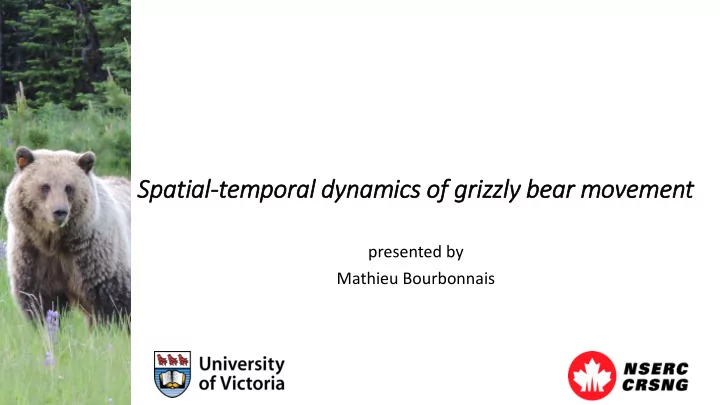

Spatial-temporal dynamics of f grizzly bear movement presented by Mathieu Bourbonnais
Research question Q3A.1 Can grizzly bear responses to disturbance, as represented by movement and health, be modeled to allow probabilistic prediction of future movement associated with changes in landscape disturbance and habitat fragmentation? 2
Movement • Link individuals/populations/landscape • Variation in space and time at multiple scales • Shifts in movement parameters/behaviours? o Time: 2001 – 2014 o Management areas • 121 individuals, 97 with multiple captures ( n = 218) • ~400 000 locations Source: Nielsen et al. (2009) B EHAVIOUR 3
Movement parameters SL = Step Lengths β = Turning Angles β B EHAVIOUR 4
Movement parameters B EHAVIOUR 5
Space use B EHAVIOUR 6
Variables 1. External 2. Internal • Disturbance (IRSS) • Cohort (Gender x Age; Mortalities) o Roads, harvest, well-sites, mines, 3. Space infrastructure, and fires • • Food (ACE Lab) Conservation areas o Seasonal food availability 4. Time (vegetation/meat) • Hourly, seasonal • Topography • Inter-annual • Vegetation indices (NDVI & DHI) o Time since hunt • Land cover B EHAVIOUR 7
Selection ratio • Ratio of hourly disturbance f and the seasonal disturbance f • SR < 1: select less than available • SR > 1: select greater than available B EHAVIOUR 8
General modelling approach • Multilevel Bayesian framework (STAN) o Group-level intercepts by bear • Response o Movement parameters (rates; space use) • Multiple combinations of variables o Time (diel; seasonal; inter- annual) + Space (CA’s) + Disturbance (SR’s; Density) + Food + Landscape Productivity (veg indices) + Topography + Land cover + Internal factors (cohort ) • Compare using WAIC B EHAVIOUR 9
Results Hourly movements (∆WAIC = 319.85) • Time of day (TOD) • Cohort • SR: Road, Harvest, Wells • Density: Road, Harvest, Wells • Food • Conservation areas • Years since hunt • TOD * SR * Density B EHAVIOUR 10
Hourly movements B EHAVIOUR 11
Hourly movements B EHAVIOUR 12
Hourly movements B EHAVIOUR 13
Results Daily movements (∆WAIC = 21913) • Season • Cohort • Density: Road, Harvest, Wells • Food • Conservation areas • Years since hunt • Season * Density B EHAVIOUR 14
Daily movements B EHAVIOUR 15
Daily movements B EHAVIOUR 16
Results Seasonal movements (∆WAIC = 62.77) • Season • Cohort • Proportion home range: harvest, roads, well-sites • Food • Conservation areas • Years since hunt • Season * PHR B EHAVIOUR 17
Seasonal movements B EHAVIOUR 18
Seasonal movements B EHAVIOUR 19
Summary • Evidence that movement rates have changed over space and time o Dependent on temporal scale o Decreasing hourly/daily and increasing seasonal o Core area generally lowest movement rates (food, security?) • Hourly scale dependent on density and “strength” of selection o High density * high selection = greater movement rates o Increasing hourly SRs represent “novel” habitat compared to HR o Link to mortality well established o Energetic requirements • Daily distance travelled / seasonal range size more dependent on density rather than selection B EHAVIOUR 20
Next steps • Hourly, daily, and seasonal models easily used for prediction of movement rates / space use • Ideally, want to predict the probability of space use and movement o Chapter 3: Third order selection over time and linkages among areas using movement probability (step selection function). • Do bears in poorer condition exhibit “risky” behaviour? o Chapter 4: Behavioural path segmentation (HMM) combined with BCI data o Could predict changes in body condition using new energetic food landscape models. B EHAVIOUR 21
Recommend
More recommend